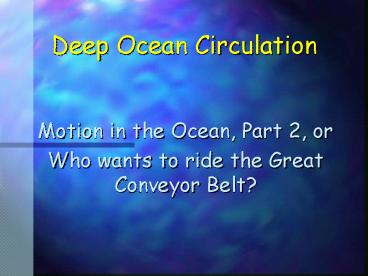Deep Ocean Circulation PowerPoint PPT Presentation
1 / 27
Title: Deep Ocean Circulation
1
Deep Ocean Circulation
- Motion in the Ocean, Part 2, or
- Who wants to ride the Great Conveyor Belt?
2
Surface Circulation
3
How does the Deep Ocean respond to Surface
Circulation?
- The main gyres move heat and salt
- Resulting DENSITY variations lead to vertical
flow (sinking) - Formation of water masses, characterized by
Temperature, Salinity
4
Density Variation in Sea Water
Isopycnals constant density
5
North Atlantic Circulation
6
Density-Driven Water Flow
- Called Thermohaline Circulation, because
temperature and salinity together determine
density of seawaterThermo temperaturehaline
salt
7
Where does the Oceans Deepest Water Come From?
- The densest seawater is cold and salty
- This is formed at high latitudes in the North and
South AtlanticNorth Atlantic Deep Water
(NADW)Antarctic Bottom Water (AABW)
8
Density of Sea Water
NADW
AABW
9
Density Rules!
10
Deep Water Masses
11
Water Massesand oceanmixing
12
Mediterranean Water
13
Mediterranean Water
14
Mediterranean Water
15
Deep Atlantic Circulation
16
Tracers in the Ocean
- Track the motion (direction and velocity)
- 14C, cosmic rays in the upper atmos
(half-life is 5700 years)3H, nuclear weapons
testing (half-life is 12.5 years)CFCs,
chlorinated fluoro-carbons
17
The Great Conveyor Belt
18
Closing Isthmus of Panama and onset of the Ice
Ages?
19
Consequences of Global Flow
- Ocean turnover is about 1500 years (time for a
round trip on the conveyor belt) - Deep water (made in the polar Atlantic) contains
abundant O2 and CO2 - The high O2 content promotes oxidation of bottom
sediments - The CO2 content controls CCD (Carbonate
Compensation Depth)
20
Carbon Cycle and Global Warming
- The temperature of bottom water formation
determines how much CO2 is dissolved in deep
ocean water - The rate of overturn of the oceans determines the
burial rate of C from the atmosphere - Organic C accumulates in sediments, depending on
the O2 content of deep ocean
21
Carbon Cycle and Global Warming
- Organic C in sediments is reduced to CH4 (methane
gas) - Methane gas migrates upward and can be trapped as
frozen gas hydrates near the ocean floor
22
Gas Hydrates
23
Gas Hydrates
24
Gas Hydrates
25
Gas Hydrates
26
Climate Change Concerns
- What happens when sea level falls?(negative
feed-back) - What happens when deep water warms?(positive
feed-back) - Both effects liberate gas hydrates (CH4), which
combines with O2 to form CO2, ultimately reaching
the atmosphere
27
Deep Ocean Circulation
- The ocean has an enormous capacity to absorb and
release greenhouse gases - So, the rate, temperature and composition of
seawater circulating through the deep ocean is
vitally important in assessing long term climate
change

